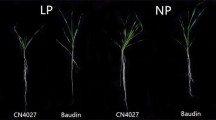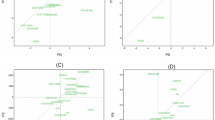Abstract
Aims
Plants can optimize the allocation of phosphorus (P) among their foliar P fractions to increase the P utilization efficiency (PUE). Identifying the genetic relationships between foliar P fractionation and PUE could provide opportunities to improve the P efficiency of barley (Hordeum vulgare L.).
Methods
The differences in the concentrations and proportions of inorganic P, ester P, nucleic acid P and insoluble P between a wild barley cultivar CN4027 and a commercial cultivar Baudin were studied, and their quantitative trait loci (QTLs) at normal P (NP) and low P (LP) fertilisations were mapped. The PUE that was determined in the previous study was used to analyze the relationship between PUE and foliar P fractionation in this research.
Results
Both cultivars of barley could increase their metabolic P fractions as an LP stress tolerance strategy to ensure their continued metabolic activities in response to LP stress. Cultivar CN4027 showed higher nucleic acid P concentration (NPC), nucleic acid P proportion (NPP) and insoluble P proportion (IPP) than cultivar Baudin under LP stress. This abundant organic P (Po) pool of CN4027 ensured the normal functioning of its metabolic pathways under LP stress. The close relationships between the foliar P fractionation and PUE could be explained by two QTL clusters, Cl-3H.02 and Cl-5H.01. The QTL cluster Cl-3H.02 is flanked by the markers bPb3256099-bPb3255630 on chromosome 3H and controls the ester P concentration (EPC), ester P proportion (EPP), insoluble P concentration (IPC) and IPP.
Conclusions
The QTL cluster Cl-3H.02 might have great potential for the future genetic improvement of barley PUE and may offer clues for the genetic relationships between the foliar P fractionation and PUE.






Similar content being viewed by others
Abbreviations
- P:
-
phosphorus
- PUE:
-
phosphorus utilization efficiency
- LP:
-
low P
- NP:
-
normal P
- QTL:
-
quantitative trait loci
- MAS:
-
marker-assisted selection
- RILs:
-
recombinant inbred lines
- PAE:
-
P acquisition efficiency
- Pi:
-
inorganic P
- Po:
-
organic P
- PiC:
-
inorganic P concentration
- EPC:
-
ester P concentration
- NPC:
-
nucleic acid P concentration
- IPC:
-
insoluble P concentration
- PiP:
-
inorganic P proportion
- EPP:
-
ester P proportion
- NPP:
-
nucleic acid P proportion
- IPP:
-
insoluble P proportion.
References
Akhtar MS, Oki Y, Adachi T (2008) Genetic variability in phosphorus acquisition and utilization efficiency from sparingly soluble p-sources by brassica cultivars under P-stress environment. J Agron Crop Sci 194:380–392
Chapin FS, Bieleski RL (1982) Mild phosphorus stress in barley and a related low-phosphorus-adapted barleygrass: phosphorus fractionations and phosphate absorption in relation to growth. Physiol Plant 54:309–317
Chen G, Habib A, Wei Y, Zheng Y, Shabala S, Zhou M, Liu C (2015) Enhancing Fusarium crown rot resistance by pyramiding large-effect QTL in barley. Mol Breed 35:26
Close D, Beadle C (2004) Total, and chemical fractionations, of nitrogen and phosphorus in Eucalyptus, seedling leaves: effects of species, nursery fertiliser management and transplanting. Plant Soil 259:85–95
Gao S, Chen G, Hu D, Zhang X, Li T, Liu S, Liu C (2017) A major quantitative trait locus controlling phosphorus utilization efficiency under different phytate-P conditions at vegetative stage in barley. J Integr Agr 16:60345–60347
Gong X, Wheeler R, Bovill WD, McDonald GK (2016) QTL mapping of grain yield and phosphorus efficiency in barley in a Mediterranean-like environment. Theor Appl Genet 129:1657–1672
Guo J, Chen G, Zhang X, Li T, Yu H, Chen H (2017) Mapping quantitative trait loci for tolerance to phosphorus-deficiency at the seedling stage in barley. Euphytica 213:114
Guo J, Chen G, Zhang X, Li T, Yu H, Liu C (2018) Quantitative trait locus analysis of adventitious and lateral root morphology of barley grown at low and high P. Funct Plant Biol 45:957–967
Hidaka A, Kitayama K (2011) Allocation of foliar phosphorus fractionations and leaf traits of tropical tree species in response to decreased soil phosphorus availability on mount Kinabalu, Borneo. J Ecol 99:849–857
Hidaka A, Kitayama K (2013) Relationship between photosynthetic phosphorus-use efficiency and foliar phosphorus fractionations in tropical tree species. Ecol Evol 3:4872–4880
Hu D, Cai L, Chen G, Zhang X, Liu C (2017) Mapping QTLs for phosphorus efficiency at tillering stage under different phosphorus levels in barley (Hordeum vulgare L.). Acta Agron Sin 43:1746–1759 in Chinese
Islamovic E, Obert DE, Oliver RE (2013) A new genetic linkage map of barley (Hordeumvulgare L.) facilitates genetic dissection of height and spike length and angle. Field Crops Res 154:91–99
Johnston AE, Poulton PR, Fixen PE, Curtin D (2014) Phosphorus: its efficient use in agriculture. Adv Agron 123:177–228
Kedrowski RA (1983) Extraction and analysis of nitrogen, phosphorus and carbon fractionations in plant material. J Plant Nutr 6:989–1011
Lambers H, Finnegan PM, Laliberté E, Pearse SJ, Ryan MH, Shane MW, Veneklaas EJ (2011) Phosphorus nutrition of Proteaceae in severely phosphorus-impoverished soils: are there lessons to be learned for future crops? Plant Physiol 156:1058–1066
Lambers H, Cawthray GR, Giavalisco P, Kuo J, Laliberte E, Pearse SJ, Scheible WR, Stitt M, Teste F, Turner BL (2012) Proteaceae from severely phosphorus-impoverished soils extensively replace phospholipids with galactolipids and sulfolipids during leaf development to achieve a high photosynthetic phosphorus-use-efficiency. New Phytol 196:1098–1108
Lambers H, Finnegan PM, Jost R, Plaxton WC, Shane MW, Stitt M (2015) Phosphorus nutrition in Proteaceae and beyond. Nat Plants 1:15109
Liao MT, Hocking PJ, Dong B, Delhaize E, Richardson AE, Ryan PR (2008) Variation in early phosphorus-uptake efficiency among wheat genotypes grown on two contrasting australian soils. Crop Pasture Sci 59:157–166
Liu T, Chen H, Yu H, Li T, Gao S, Chen G (2016a) Characteristic of foliar phosphorus utilization in barley at low-phosphorus deficiency. Chinese Bulletin Bot 51:504–514 (in Chinese)
Liu T, Cai Q, Zhang X, Li T, Yu H, Guo J, Chen G (2016b) Response characteristics in root morphology and root exretion of P-efficient wild barley exposured to low level of phytate-phosphorus. J Plant Nutr Fertilizer 22:1538–1547 (in Chinese)
Mao R, Zeng D, Zhang X, Song C (2015) Responses of plant nutrient resorption to phosphorus addition in freshwater marsh of Northeast China. Sci Rep 5:8097
Rose TJ, Wissuwa M (2012) Rethinking internal phosphorus utilization efficiency: a new approach is needed to improve PUE in grain crops. Adv Agron 116:185–217
Shen J, Li H, Neumann G, Zhang F (2005) Nutrient uptake, cluster root formation and exudation of protons and citratein Lupinus albusas affected by localized supply of phosphorus in a split-root system. Plant Sci 168:837–845
Tachibana S (1987) Effect of root temperature on the concentration of various forms of phosphorus in cucumber and figleaf gourd plants. J Acoust Soc Am 56:805–808
Van Ooijen JW (2004) ‘MapQTL version 5.0. Software for the mapping of quantitative trait loci in experimental populations.’ (Kyazma BV:Wageningen)
Veneklaas EJ, Lambers H, Bragg J, Finnegan PM, Lovelock CE, Plaxton WC, Price CA, Scheible W, Shane MW, White PJ, Raven JA (2012) Opportunities for improving phosphorus-use efficiency in crop plants. New Phytol 195:306–320
Voorrips RE (2002) MAPCHART: software for the graphical presentation of linkage maps and QTLs. J Hered 93:77–78
Wang X, Shen J, Liao H (2010) Acquisition or utilization, which is more critical for enhancing phosphorus efficiency in modern crops? Plant Sci 179:302–306
Wang W, Ding G, White P, Wang X, Jin K, Xu F, Shi L (2018) Mapping and cloning of quantitative trait loci for phosphorus efficiency in crops: opportunities and challenges. Plant Soil, published online. https://doi.org/10.1007/s11104-018-3706-6
Yang M, Ding G, Shi L, Xu F, Meng J (2011) Detection of QTL for phosphorus efficiency at vegetative stage in brassica napus. Plant Soil 339:97–111
Zheng Z, Wang HB, Chen GD, Yan GJ, Liu CJ (2013) A procedure allowing up to eight generations of wheat and nine generations of barley per annum. Euphytica 191:311–316
Acknowledgements
This work was supported by the National Natural Science Foundation (31401377), Science and Technology Project of Sichuan Province (2014NZ0008; 2017JY0126) and Key Project of Education Department of Sichuan Province (14ZA0002).
Author information
Authors and Affiliations
Corresponding authors
Additional information
Responsible Editor: Hans Lambers.
Publisher’s note
Springer Nature remains neutral with regard to jurisdictional claims in published maps and institutional affiliations.
Highlights
• The wild barley cultivar CN4027 showed a stronger organic P pool to improve P utilization efficiency (PUE) than the commercial barley cultivar Baudin.
• The relationships between foliar P fractionations and PUE could be explained by the coincidence of quantitative trait loci (QTLs) for these traits.
• The QTL cluster Cl-3H.02 could have great potential for future genetic improvement of P efficiency in barley.
Electronic supplementary material
ESM 1
(DOCX 110 kb)
Rights and permissions
About this article
Cite this article
Guo, J., Ye, D., Chen, G. et al. Coincidence of QTLs determining foliar phosphorus fractionation patterns and phosphorus utilization efficiency in barley under low phosphorus stress. Plant Soil 441, 349–362 (2019). https://doi.org/10.1007/s11104-019-04128-4
Received:
Accepted:
Published:
Issue Date:
DOI: https://doi.org/10.1007/s11104-019-04128-4




